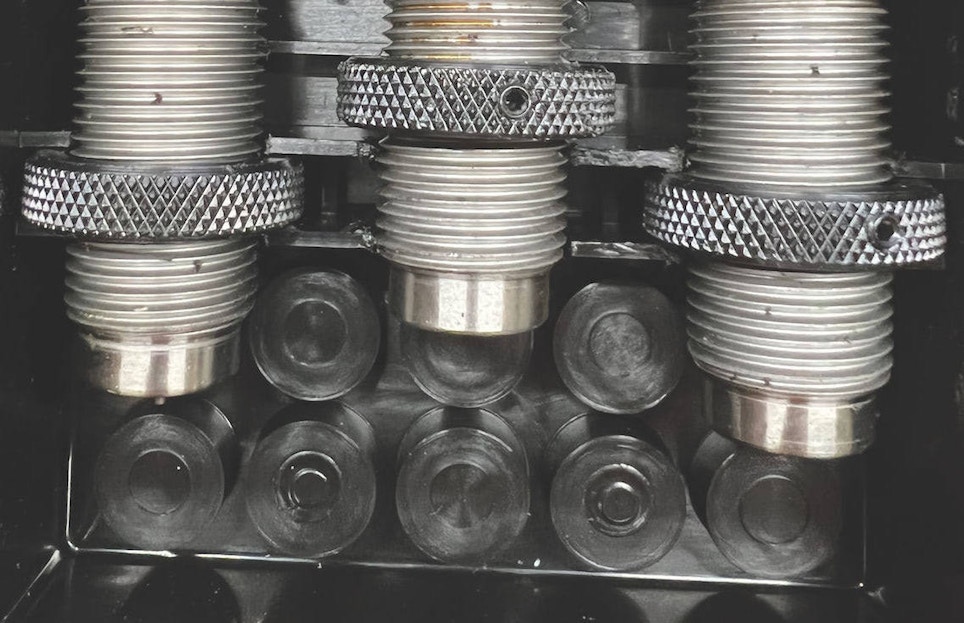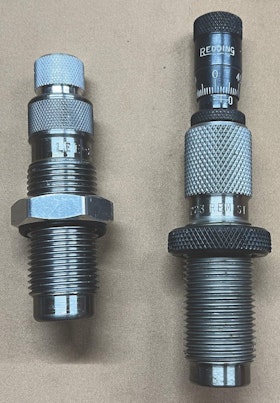You’ve sold your customer a reloading kit. Now all that’s left to do is help them with their reloading dies. In most cases, the standard reloading dies from any manufacturer are sufficient but there are a few considerations beyond the basics.
Rifles
Suppose your customer is loading for rifle, some points need to be made. If they only have a single-shot or bolt-action rifle and plan to reload only for only that one rifle, it’s not necessary to have a full-length sizing die. They will get better accuracy by sizing only the neck to take a new bullet. When a rifle cartridge is fired, the brass is expanded from its original size by the heat and pressure and forms itself to the rifle’s chamber. As the pressure falls off and the heat dissipates, the brass contracts slightly, thus making it easy to extract.
The cartridge could be re-inserted back into the chamber and fit perfectly because the brass is now formed to that particular chamber. This same brass may not load into another rifle’s chamber since there are slight variations in the manufacturing process. But for this one rifle, they’ve got the perfect brass to re-use. Suppose they are loading the same caliber for multiple rifles or semi-automatic and fully automatic rifles. In that case, they’ll need to resize the entire length of the brass to return to SAAMI standards and work correctly in all chambers, magazines, and feeding ramps. Some die sets (like Redding Deluxe Die Sets) come with full-length and neck-only resizing dies.
Bullet Seating
There are different bullet seating dies based on the precision needed for the specific application. The standard seating die is sufficient if your customers are making practice ammo or general-use ammo. Set it to the proper seating depth and load away. If they’re loading for competition and extreme accuracy, spending the extra cash for micrometer-adjustable seating dies is worthwhile. These allow precise seating depths down to .001 inch.
Dedicated De-Capping Die
Reloading dies typically resize the brass and remove the primer in one operation. But many shooters have a dedicated de-capping die that they use for their cartridges. This doesn’t resize but only removes the primer before cleaning the brass. After the brass is cleaned, the sizing will be more accurate. Many swear by the RCBS .22-25 HD de-cap die for this.
Factory Crimp Die
While rifle dies will allow you to crimp the brass around the seated bullet without purchasing a separate die, the consensus in the shooting community is that the Lee Factory Crimp die is a worthwhile purchase. Rather than using the seating die to both seat the bullet and crimp the case, Lee separates this process into separate operations. Unlike most crimp dies that crimp by applying downward pressure on the case, the Lee die uses a collet that squeezes the brass and provides a more consistent crimp without the possibility of affecting the case body. I’ve not used one yet, but it may be worth the customer’s time if they want the best crimp possible.
Pistols
The primary choice when selecting pistol dies concerns whether to choose the standard steel dies or the tungsten-carbide dies (generally called carbide dies). Standard dies require that the cases be lubricated when going through the resizing process. If the customer has steel dies that are still in good condition, they just need lube and a lube pad. However, if they want to bypass this often-messy step, they should upgrade to the carbide die sets. These require no case lubrication. I have loaded thousands of rounds, and they are still going strong.
I’ve recently ordered Hornady’s Titanium Nitride dies sets in .45ACP. These are supposed to give the same non-lube properties as the carbide dies with the added benefit of reducing friction, preventing stuck cases, and increasing case life. These are an option in place of the carbide dies, though I have no personal experience with them yet.
Three- or Four-Die Sets
Most pistol die sets contain three dies: the resize/de-cap die, the expanding/powder-through die, and the seating/crimp die. Lee Precision offers a four-die set. The only difference is that the four-die set includes the factory crimp die mentioned earlier. A three-die set will do the job for your customers. But if they are interested in the Lee Factory Crimp die, they can upgrade to the four-die set. Just as for rifles, this added die is sold separately for those who already have die sets.
We’ve covered some specific questions and scenarios here, but this isn’t a complete overview of dies. It is best to consult reloading manuals or the manufacturers’ websites for more detailed information.








